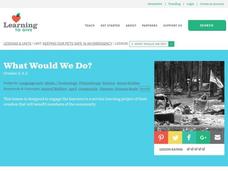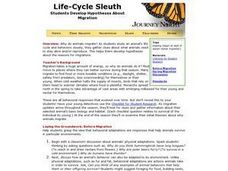Curated OER
Double Trouble?
Students investigate cloned meat and animal products. In this food safety lesson, students research the noted Web sites in search of information about cloning and food labelling. Students use their findings to create informative...
Curated OER
Safe Food: It's Your Job Too!: Health
High schoolers get an overview of the importance of food safety and become familiar with common foodborne pathogens.
Curated OER
Dispose of Waste Properly
Students explore biology by participating in an environmental role-play activity. In this animal waste lesson, students identify the appropriate way to dispose of human and animal waste when staying outdoors. Students conduct an outdoor...
Curated OER
Introducing Working Animals
Students identify ways humans and animals work together. In this animal welfare lesson, students read the text Hanni and Beth: Safe and Sound and define the term "working animals." Students investigate working animals by visiting various...
Curated OER
Computer Security:
Students watch a video on computer safety and then complete activity sheets about the characters in the video. In this safety lesson plan, students are provided with the worksheets.
Curated OER
The Battle to Save Bats
Students investigate the disease that is causing the global decline of bats. In this animal health lesson, students read an article which discusses white-nose syndrome, the number one killer of bats. Students discuss ways to keep bats...
Curated OER
Keeping Our Pets Safe in an Emergency
Students participate in a service learning project to benefit the members and animals in their community. In this animal welfare lesson, students review emergency preparedness. Students discuss animal safety in an emergency. Students...
Curated OER
A Safe Food Supply? Is Your Food Safe to Eat?
Viewers of this slide show learn that pesticides used on food crops can be harmful, but that there are certain allowable levels that should not be hazardous. They find out the rigorous process of inspection that meat must go through...
Curated OER
Plant and Animal Cells
Students investigate the difference between plant and animal cells. They observe a variety o plant and animals cells by looking at a piece of cork, an onion, elodea, prepared slides of paramecium, human bone, frog blood, and human...
Curated OER
What Would We Do?
Students develop an emergency plan for their pets. In this animal welfare lesson, students discuss how to keep their pets safe in an emergency and create pet emergency kits.
Missouri Department of Elementary
What Is Comfortable and Uncomfortable Touch?
Two stuffed animals open a activity that examines two types of touch. Scholars discuss the difference between comfortable and uncomfortable touch. They offer examples then brainstorm ways an individual can keep safe from uncomfortable...
American Chemical Society
Changing State: Freezing
There are five types of frost: ground frost, air frost, hoar frost, glaze, and rime. Scholars mix ice and salt in a metal container to observe frost forming on the outside of the can. Animations and videos enhance the learning.
Curated OER
Safe Or Sorry-- Risky And Non- Risky Lunch Box Choices
In this health activity, students discover that some foods are safe to have in a lunch box at room temperature, and some foods are risky and need a cold pack. Students sort common foods as risky (and tell the reason why) or safe....
Curated OER
Life-Cycle Sleuth
Students analyze an animal's life cycle and behaviors, and examine what animals need to stay alive and reproduce. They develop theories and hypotheses about the reasons for migrations, using the Journey North online project.
Curated OER
Who Takes Care of the Maya Forest Corridor?
First graders study the animals in the Maya Forest Reserve. In this conservation instructional activity, 1st graders create a graph to compare the environment of animals to their own. They design a 3D model of these two environments.
Curated OER
Elastic Recoil in Arteries and Veins
A lab in which high schoolers examine the difference between arteries and veins. Budding biologists will find out which blood vessel can stretch furthest, recording their data in a table then answering several questions evaluating their...
Curated OER
Genetically Modified Food (GMF)
Explore genetically modified foods through various experiments. In this biology lesson, students discuss the safety issues related to GMF's. They conduct a PCR analysis to identify the presence of genetic modification.
Curated OER
Disasters (Natural & Man-made)
Students chose a natural or man-made disaster, such as a tornado or an oil spill, to research using the assigned web sites. They choose a presentation type from a list which includes poetry, radio broadcasts, and safety brochures, to...
Perkins School for the Blind
Familiar Sounds
To foster concept development and auditory discrimination skills, learners with visual impairments listen to identify a variety of common sounds. The teacher makes recordings of various sounds, including those found in the home, at the...
Cornell University
Diffraction Demystified
Study diffraction patterns using CDs and DVDs! Scholars measure the diffraction patterns of a light wave as it hits a CD or DVD. Using the information, they can measure the distance between the tracks.
PBS
Print Hints
It would be a crime not to give the lesson a chance! An inquiry-based lesson has pupils assume the role of crime scene investigators as they make observations about shoe prints. They look for patterns in the prints such as distance and...
Curated OER
What Does That DNA Molecule Really Look Like???
Students extract DNA from animal liver cells. They separate, collect and describe the appearance from the extracted DNA while role playing as an intern in a city's forensics.
Curated OER
The Circus Train
Students study the safety message "Stay Back from tracks and trains!" students count animals and train cars, and repeat The Circus Train poem
Curated OER
Wandering in Washington
Learners plan a sightseeing and shopping trip around Washington, DC taking into account train safety messages. They write about the experience in their jounals and must include five safety messages.
Other popular searches
- Small Animal Safety
- Teaching Animal Safety
- Science Animal Safety
- Animal Safety Vocabulary
- Animal Safety Lesson

























